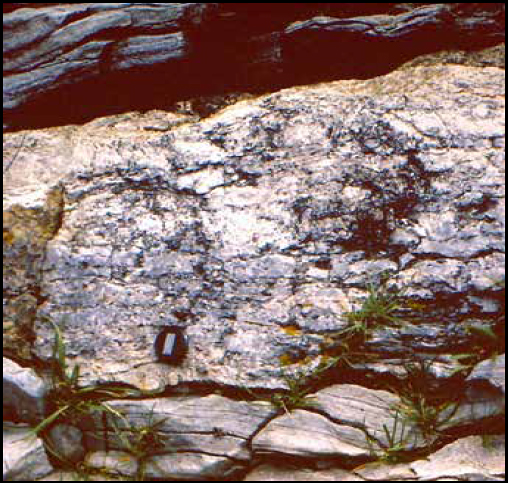Articles
Neoproterozoic U–Pb (zircon) and 40Ar/39Ar (muscovite) ages from granitic pegmatite clasts, basal Ross Island Formation, Grand Manan Island, New Brunswick, Canada
ABSTRACT
Zircon grains from a granitic pegmatite clast from conglomerate at the base of the Ross Island Formation on Grand Manan Island indicate an igneous crystallization age of 664.1 ± 4.6 Ma. The clast also contains abundant older inherited grains back to the Archean. Muscovite in the same clast and an additional similar clast yielded cooling ages of 607.0 ± 3.7 Ma and 619.6 ± 4.1 Ma, respectively, providing a maximum depositional age for the host conglomerate of the Ross Island Formation. The Seven Hundred Acre Island Formation in the Islesboro block in Penobscot Bay, Maine, contains a granitic pegmatite dyke of similar age, suggesting that it was close to the site of deposition of the Ross Island Formation of Grand Manan Island in the late Ediacaran. This suggestion is supported further by similarity in rock types and detrital zircon spectra between the Seven Hundred Acre Island Formation and The Thoroughfare and Kent Island formations on Grand Manan Island.
RÉSUMÉ
Des grains de zircon provenant d’un claste de pegmatite granitique du conglomérat à la base de la Formation de Ross Island sur l’île Grand Manan signalent une cristallisation ignée survenue il y a 664,1 ± 4,6 Ma. Le claste renferme également une abondance de grains hérités plus âgés remontant à l’Archéen. La muscovite dans le même claste et un claste similaire supplémentaire a accusé des âges de refroidissement de 607,0 ± 3,7 Ma et de 619,6 ± 4,1 Ma, respectivement, ce qui définit l’âge maximal de la sédimentation du conglomérat hôte de la Formation de Ross Island. La Formation de Seven Hundred Acre Island dans le bloc d’Islesboro à l’intérieur de la baie de Penobscot, dans le Maine, abrite un dyke de pegmatite granitique d’âge similaire, ce qui laisse supposer qu’il se trouvait près de l’emplacement de la sédimentation de la Formation de Ross Island sur l’île Grand Manan au cours de l’Édiacarien tardif. La similarité des types rocheux et des spectres de zircons détritiques entre la Formation de Seven Hundred Acre Island et les formations de Thoroughfare et de Kent Island sur l’île Grand Manan appuient une telle supposition.
[Traduit par la redaction]
INTRODUCTION
1 Pre-Mesozoic rocks are exposed on the southeastern third of Grand Manan Island and adjacent offshore islands in the Bay of Fundy (Figs. 1, 2). Published U–Pb (zircon) ages have demonstrated that most of these rocks are Late Neoproterozoic to Early Cambrian (Miller et al. 2007; Fyffe et al. 2009; Fyffe 2014), and the range of ages and rock types has led to the interpretation that they correlate with the New River and Mascarene terranes of southern New Brunswick (Miller et al. 2007; Fyffe 2014). However, some units on Grand Manan Island show similarities in rock types and ages to components in the Islesboro block in Penobscot Bay in coastal Maine (Stewart et al. 2001; Reusch et al. 2018), and hence correlation with that area is also possible.
2 The purpose of this paper is to report U–Pb zircon and 40Ar/39Ar muscovite ages from cobble- to boulder-sized granitic pegmatite clasts in a conglomerate that occurs at the base of the Ross Island Formation on Grand Manan Island (Fig. 2). Muscovite from these clasts previously had yielded K–Ar ages of 640 Ma and 590 Ma (Leech et al. 1963; Lowdon et al. 1963). The provenance of these clasts is unknown, as similar rocks are not exposed elsewhere on Grand Manan Island (e.g., Black 2005). However, a similar U–Pb zircon age of 646.7 ± 2.7 Ma was reported by Stewart et al. (2001) for a granitic pegmatite dyke that cuts the deformed and metamorphosed Seven Hundred Acre Island Formation in the Islesboro block in Penobscot Bay, Maine (Fig. 1). This date, combined with the previous K–Ar results and a field excursion led by David Stewart to the Penobscot Bay area in 1999 (see Appendix), prompted the work reported here to investigate further whether the Islesboro block pegmatite might be the source of pegmatite clasts in the Ross Island Formation.
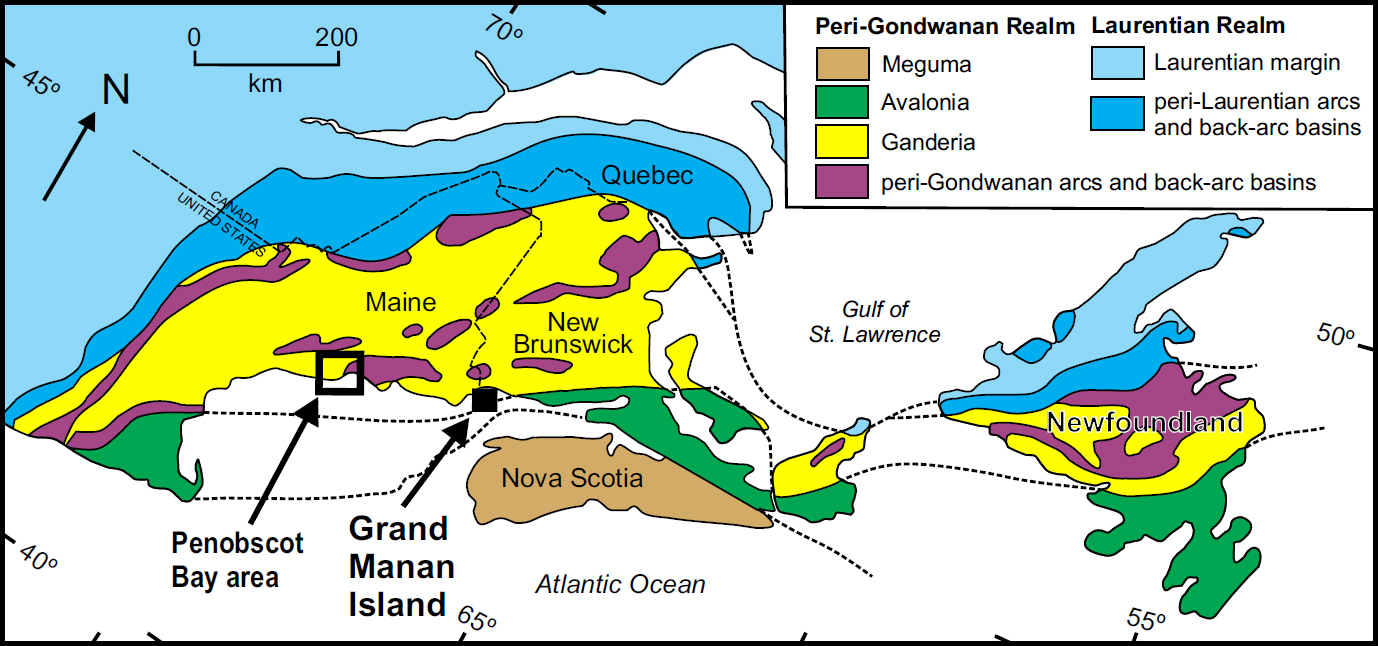 Display large image of Figure 1
Display large image of Figure 1
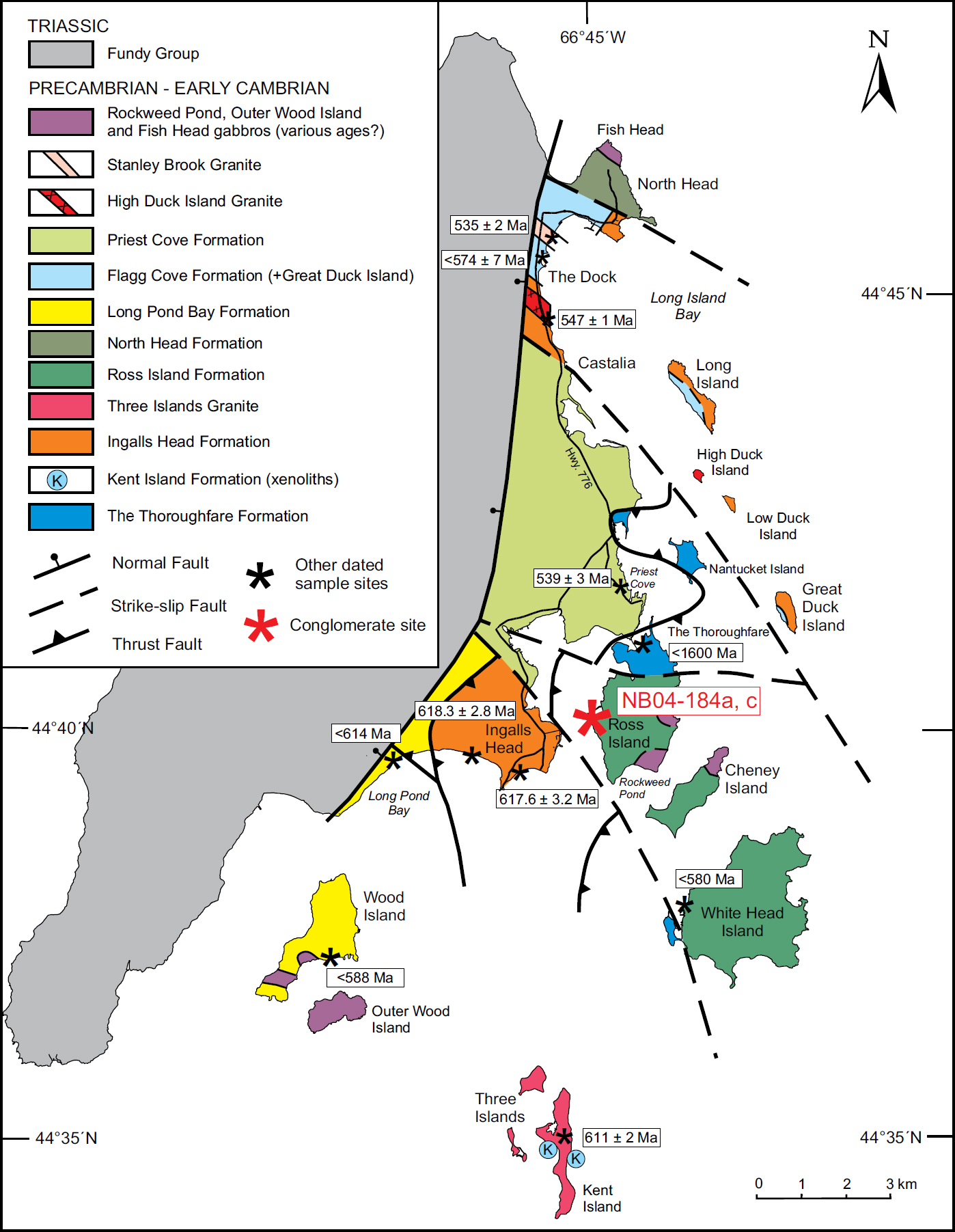 Display large image of Figure 2
Display large image of Figure 2
GEOLOGICAL SETTING
3 The distribution, age, and stratigraphic relations among pre-Mesozoic rock units on Grand Manan Island remain somewhat uncertain because of abundant faults and lack of age constraints on some units. The map shown in Figure 2 is based on Fyffe (2014), with a modified legend, and is derived from earlier maps by Fyffe and Grant (2000, 2001, 2005), mapping and structural and petrological studies by Black (2005), and ages reported by Miller et al. (2007), Fyffe et al. (2011), and Barr et al. (2017; 2019).
4 The Thoroughfare Formation is composed of intercalated, grey, thin- to medium-bedded quartzite, sideritic siltstone, and black carbonaceous chloritoid schist and overlying thick-bedded to massive white quartzite (Black 2005; Fyffe 2014). It is interpreted to occur in a klippe in the Ross Island - Priest Cove area, and in a fault-bounded sliver on the west side of White Head Island (Fig. 2). Age constraints are provided only by a detrital zircon sample which contains mainly grains with ages of ca. 2 Ga (Barr et al. 2017; 2019). Only 2 grains have younger ages of ca. 1.65 Ga, interpreted as the maximum depositional age of the sample. The presence of quartzite pebbles, possibly derived from The Thoroughfare Formation, in the ca. 618 Ma Ingalls Head Formation in the southern part of the Ingalls Head coastal section (Black 2005) suggests that The Thoroughfare Formation is older than ca. 618 Ma. Hence these rocks are interpreted to be the oldest on Grand Manan Island, with the possible exception of the Kent Island Formation which is represented only by large xenoliths of marble and magnetite-rich skarn in the Three Islands Granite on the eastern and western shores of Kent Island (Fig. 2). The relationship of these xenoliths and their host granite to the other units on Grand Manan Island is uncertain because of their isolated location on off-shore islands. The granite yielded a U–Pb (zircon) age of 611 ± 2 Ma (Miller et al. 2007).
5 The Ingalls Head Formation consists of felsic to mafic flows and tuff, green and purple laminated mudstone, and volcanic breccia. Fyffe (2014) included the Long Island Bay Formation of Black (2005) and Miller et al. (2007) as part of the Ingalls Head Formation, rather than as a separate unit, although the latter authors interpreted it to overlie the Ingalls Head Formation. Granitic rocks on the shore of Long Island Bay intruded maroon siltstone of the Long Island Bay Formation of Miller et al. (2007) and yielded an age of 547 ± 1 Ma, and rhyolite and felsic tuff in the Ingalls Head Formation on Ingalls Head yielded ages of 618.3 ± 2.8 and 617.6 ± 3.2 Ma, respectively (Miller et al. 2007).
6 Stratigraphic relations among the remaining pre-Mesozoic units are not known with certainty, but limited age information suggests that all are late Neoproterozoic to earliest Cambrian (Fig. 2). The Ross Island Formation is a thick sequence of mafic flows locally interbedded with pillow basalt, basaltic breccia, chert, and laminated siltstone, associated with medium-grained gabbroic rocks. The distinctive conglomerate at its base that was sampled for this study is associated with peperitic basalt and contains cobble- to boulder-sized clasts of granite, granitic pegmatite, micaceous white quartzite, and various other metamorphic rocks (Fig. 3). Detrital zircon from siltstone in a peperitic sample from the Ross Island formation on White Head Island yielded a large population at ca. 600 Ma and a maximum depositional age of ca. 580 Ma based on the youngest grains in the sample (Barr et al. 2017; 2019). The North Head Formation also is composed dominantly of mafic volcanic rocks but lacks the sedimentary component. Minor felsic dykes in the unit failed to yield zircon and hence the formation remains undated.
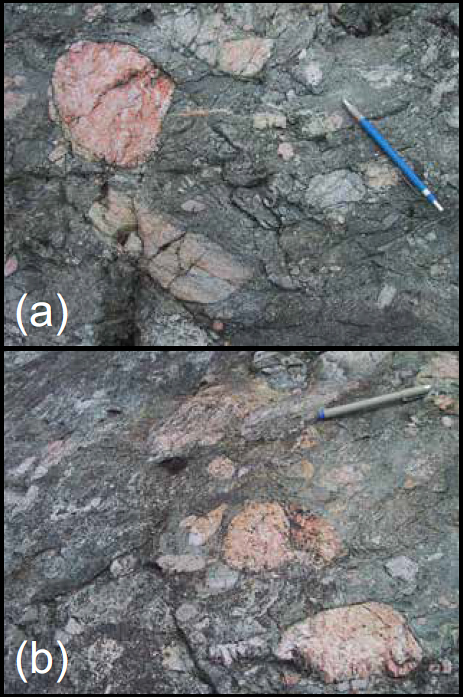 Display large image of Figure 3
Display large image of Figure 3
7 The Long Pond Bay Formation on the western shore of Long Pond Bay consists of subaqueous hyaloclastic basalt flows, mafic volcanic breccia, peperitic basalt, green cherty mudstone, and medium- to thick-bedded wacke. Amygdaloidal basalt flows, felsic tuff, and arkosic sandstone that appear to have been deposited in shallower water occur offshore on Wood and adjacent islands, associated with coarse-grained gabbroic rocks. Their weak metamorphism and minimal deformation relative to other units in the area suggest that they may be the youngest pre-Mesozoic rocks exposed on the Grand Manan archipelago. Their age is constrained by a less than 588 Ma result from a felsic tuff on Wood Island (Miller et al. 2007) and a detrital zircon peak at 618 Ma and maximum depositional age of ca. 614 Ma (Barr et al. 2017; 2019).
8 Basalt-quartzite-siltstone pebble (to cobble) conglomerate, interpreted as the basal unit of the Flagg Cove For-mation by Black (2005) or a separate unit called the Great Duck Island Formation (Fyffe and Grant 2001; Fyffe 2014) unconformably overlies basaltic flows of the Ingalls Head/Long Island Bay Formation on Great Duck Island (Fig. 2). The Flagg Cove Formation above the basal conglomerate consists of thin-bedded quartzite and grey sideritebearing siltstone, and is intruded by the Stanley Brook Granite, from which a granitic sample yielded an age of ca. 535 ± 2.5 Ma (Fyffe et al. 2011), constraining the minimum age of the Flagg Cove Formation to earliest Cambrian. The youngest detrital zircon population at 574 ± 7 Ma provides a maximum depositional age (Fyffe et al. 2009). The Priest Cove Formation consists of coarse- to fine-grained mafic tuff, volcaniclastic sandstone, siltstone, and intermediate crystal - lithic lapilli tuff. An age of 539.0 ± 3.3 Ma from a dacitic lithic - crystal tuff demonstrates that the Priest Cove Formation is latest Ediacaran to earliest Cambrian.
DATED SAMPLES
9 Granitic pegmatite samples NB04-184a and 184c were collected from the basal conglomerate unit of the Ross Island Formation exposed on the west coast of Ross Island (Fig. 2; UTM coordinates, grid zone 19: 678548E, 4948048N). The conglomerate contains cobble- to boulder-sized clasts of granite, granitic pegmatite, micaceous white quartzite, and quartz-muscovite schist as well as large muscovite booklets set in a dark green muscovite- and chlorite-rich matrix (Fig. 3). Locally, some large lenses of matrix several metres across are more tuffaceous and best described as a mafic crystal lithic tuff. Grain sizes within these tuffaceous horizons range from fine to medium.
10 The dated samples are both foliated pegmatite with large K-feldspar (microcline) crystals up to 10 cm in length accompanied by finer-grained plagioclase, quartz, and muscovite. Chlorite occurs as a secondary mineral along grain boundaries parallel to the foliation but no biotite is apparent. The feldspars are moderately altered to sericite and saussurite, and myrmekitic texture is abundant in plagioclase. Muscovite and zircon were recovered from samples NB04-184a and 184c using standard mineral separation techniques.
U–PB GEOCHRONOLOGY
11 Sample NB04-184c yielded only a few grains of zircon, which were not analyzed. Sample NB04-184a contained a larger but still small number of zircon grains which were heterogeneous in appearance, with most grains showing multifaceted to rounded morphologies. Some grains contained visible cloudy cores. In view of the peraluminous composition of the pegmatite clast it was anticipated that the U–Pb systematics of the zircon grains were likely to be complex, with a strong likelihood that both xenocrystic zircon and zircon grains containing older inherited cores would be present. Thirty individual grains were selected for analysis; these comprised the most euhedral grains, most of which showed no visible cores. However, cathodoluminescence imaging was not done on the grains.
12 A total of 24 grains were analyzed by laser ablation (LA-) ICP-MS methods at the Pacific Centre for Isotopic and Geochemical Research (PCIGR) at the University of British Columbia, using methods as described in Barr et al. (2011). Analyses were done using line scans rather than spot analyses with the laser. Although cathodoluminescence imaging of the zircons was not utilized in this study, a few of the selected grains showed clear igneous zircon rims surrounding rounded, locally inclusion-rich inherited cores. Four of the analyses that yielded young 206Pb/238U ages were from somewhat coarser zircon grains that had sufficiently thick clear rims to provide confidence that only young igneous zircon was analyzed. Analytical data are presented in Table 1 and plotted on conventional U–Pb concordia plots (Figs. 4a, b) and on a plot of 206Pb/238U ages for the four individual youngest grains (Fig. 4c). The results clearly indicate that a large component of the zircon contained in the pegmatite sample comprises older zircon, most of which likely occurs as inherited cores, along with some entirely xenocrystic grains. These older zircon components yield clusters of ages at 759 ± 5 Ma (n = 6), 930 ± 37 Ma (n = 3), 1013 ± 44 Ma (n = 3) 1171 ± 29 Ma (n = 1), 1257 ± 50 Ma (n = 3), and four additional analyses with ages from 1454 to 2664 Ma. The best estimate for the crystallization age of the sample is thought to be given by the youngest cluster of four analyses. Three of these analyses give a weighted 206Pb/238U age of 664.1 ± 4.6 Ma (MSWD = 0.43; probability of fit = 0.65), which is interpreted to indicate the crystallization age of the sample. The fourth analysis gives a slightly younger age of 646.0 ± 3.4 Ma, possibly reflecting minor post-crystallization Pb-loss.
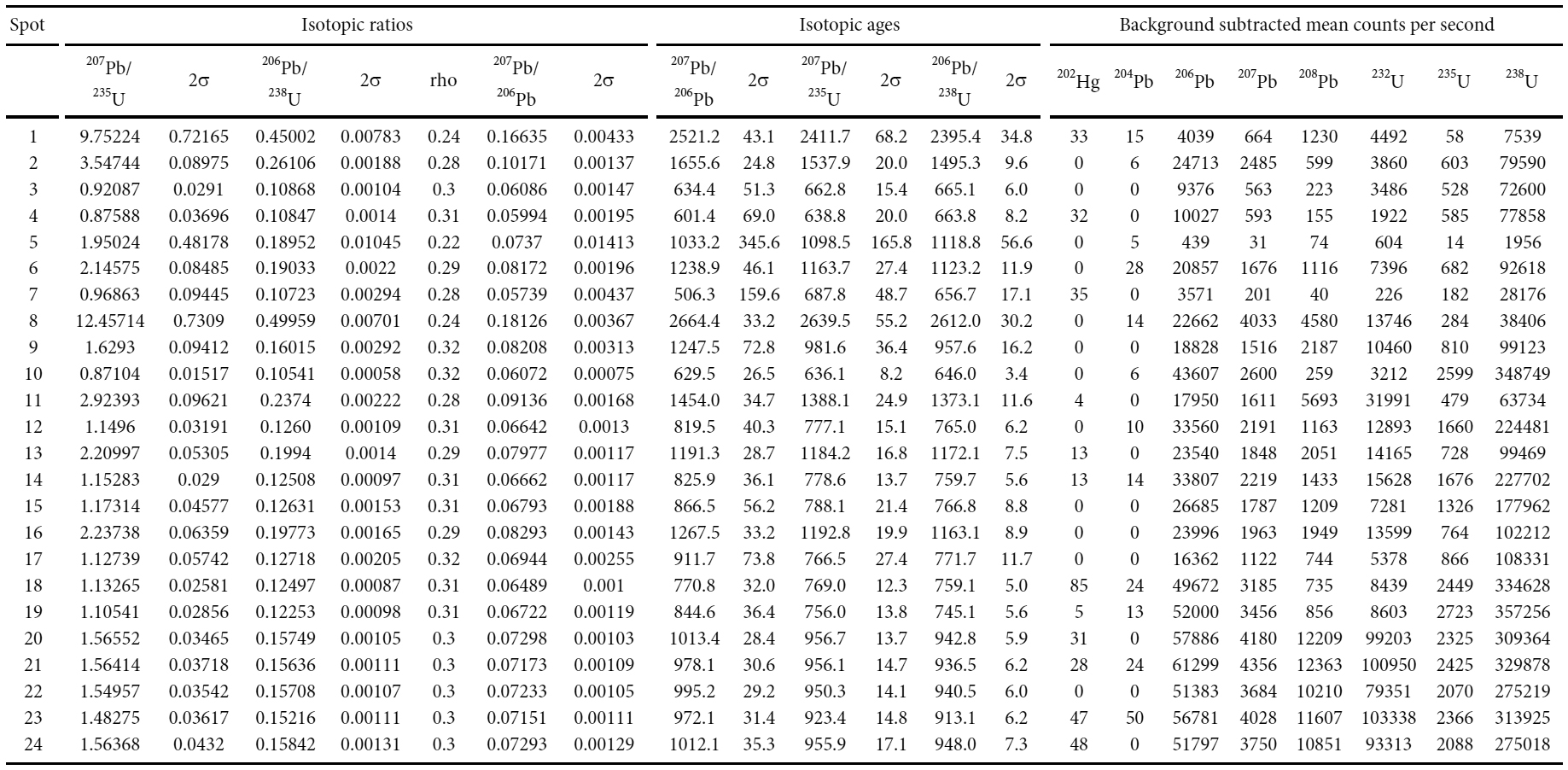 Display large image of Table 1
Display large image of Table 1
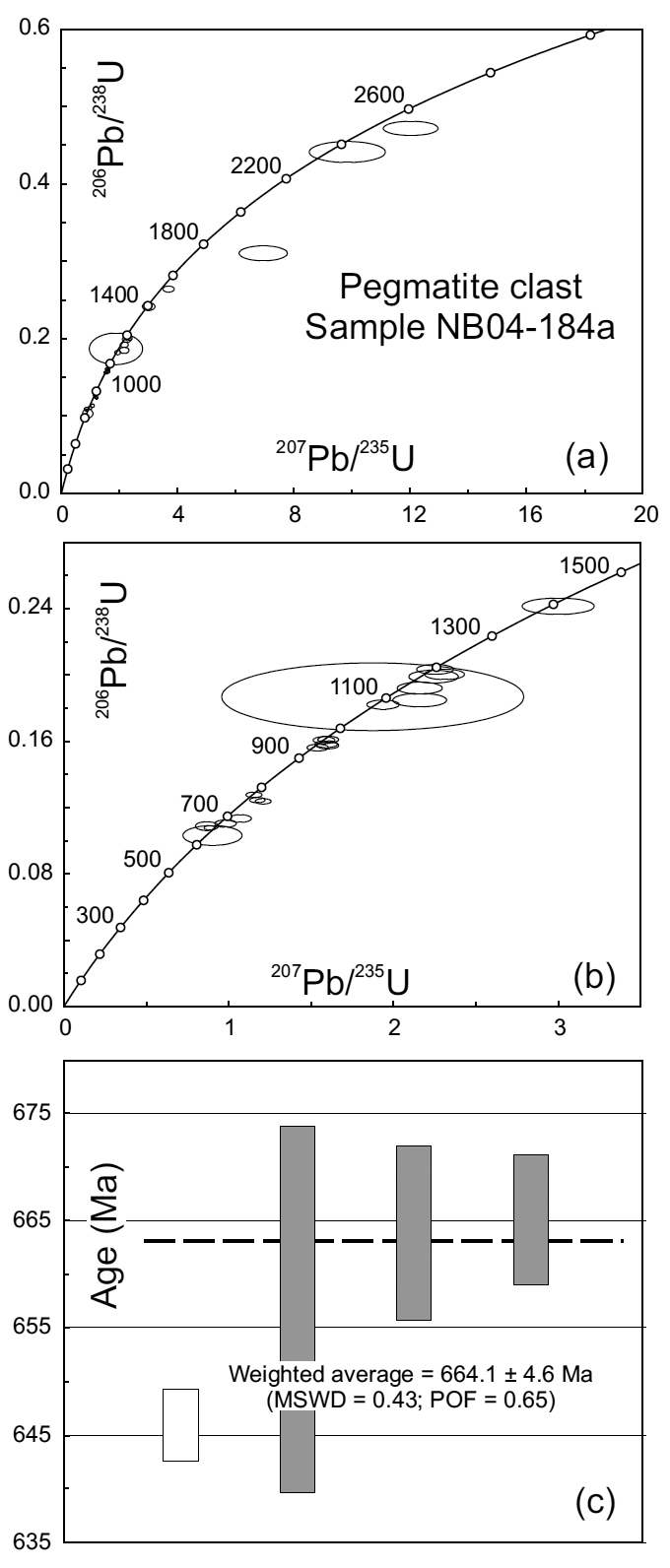 Display large image of Figure 4
Display large image of Figure 4
40AR/39AR GEOCHRONOLOGY
13 The 40Ar/39Ar dating was carried out on coarse-grained muscovite separated from both samples NB04-184a and 184c. Mineral separates were wrapped in aluminum foil and stacked in an irradiation capsule with similar-aged samples and neutron flux monitors (Fish Canyon Tuff sanidine (FCs), 28.02 Ma (Renne et al. 1998). The samples were irradiated at the McMaster Nuclear Reactor in Hamilton, Ontario, for 90 MWH, with a neutron flux of approximately 6 × 1013 neutrons/cm2/s. Analyses (n = 45) of 15 neutron flux monitor positions produced errors of <0.5% in the J value. The samples were analyzed at the Noble Gas Laboratory at the PCIGR. The mineral separates were step-heated at incrementally higher powers in the defocused beam of a 10W CO2 laser (New Wave Research MIR10) until fused. The gas evolved from each step was analyzed by a VG5400 mass spectrometer equipped with an ion-counting electron multiplier. All measurements were corrected for total system blank, mass spectrometer sensitivity, mass discrimination, radioactive decay during and subsequent to irradiation, as well as interfering Ar from atmospheric contamination and the irradiation of Ca, Cl, and K with the following isotope production ratios: (40Ar/39Ar)K = 0.03020 ± 0.00006; (37Ar/39Ar)Ca = 1416.4 ± 0.5; (36Ar/39Ar)Ca = 0.3952 ± 0.0004; Ca/K = 1.83 ± 0.01(37ArCa/39ArK).
14 Analytical results are presented in Table 2. Plateau and correlation ages were calculated using Isoplot ver. 3.09 (Ludwig 2003). Errors are quoted at the 2σ (95% confidence) level and are propagated from all sources except mass spectrometer sensitivity and age of the flux monitor.
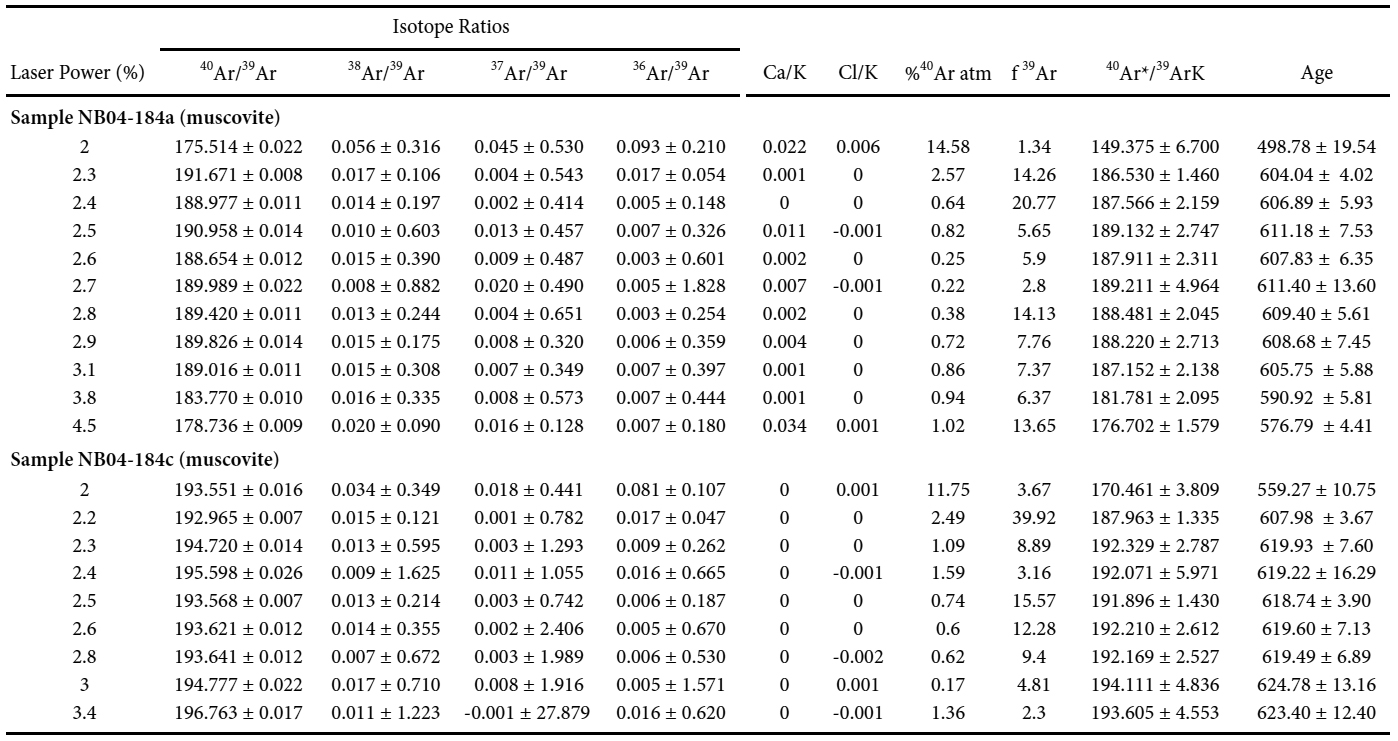 Display large image of Table 2Notes: All errors are given at the 2-sigma level; f39Ar = proportion of 39Ar released in each step (total = 100)
Display large image of Table 2Notes: All errors are given at the 2-sigma level; f39Ar = proportion of 39Ar released in each step (total = 100) 15 Muscovite from sample NB04-184a yielded a well-defined plateau comprising 78.6% of the 39Ar (Fig. 5a), which corresponds to an age of 607.0 ± 3.7 Ma. Muscovite from sample NB04-184c yielded a rising age spectrum, with the final seven heating steps (comprising 56.4% of the 39Ar) defining a plateau with an age of 619.6 ± 4.1 Ma (Fig. 5b).
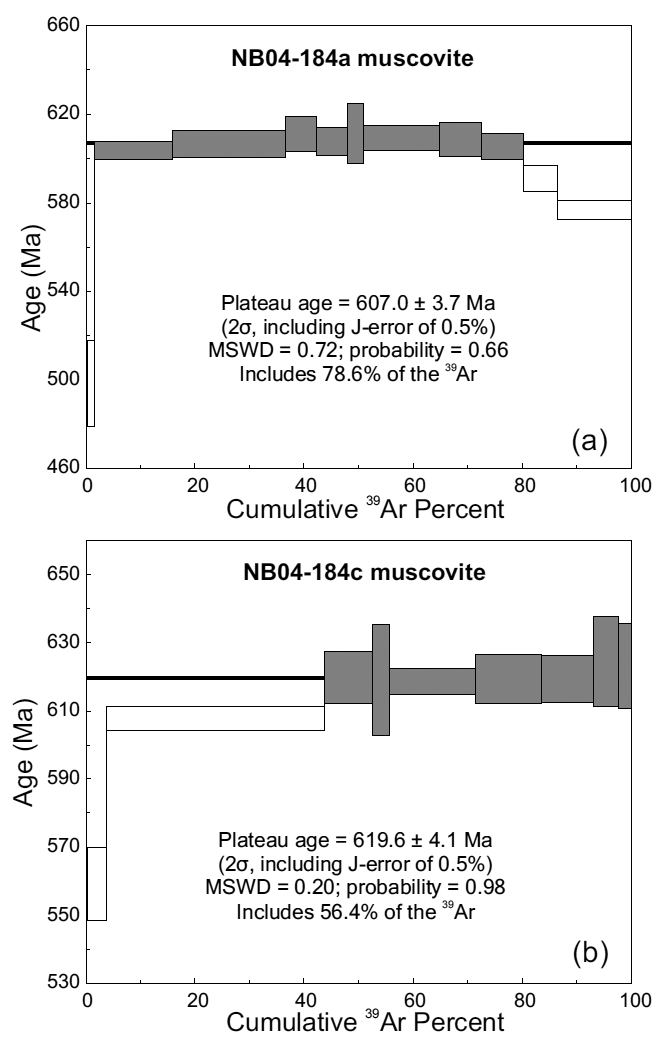 Display large image of Figure 5
Display large image of Figure 5
IMPLICATIONS OF THE RESULTS
16 The muscovite cooling ages of ca. 620 to 600 Ma provide a maximum depositional age for the host conglomerate of the Ross Island Formation which is consistent with the maximum age of <580 Ma inferred from detrital zircon ages (Barr et al. 2017; 2019). The interpreted igneous crystallization age of 664.1 ± 4.6 Ma is somewhat older than the weighted mean 207Pb/206Pb age of 646.7 ± 2.7 Ma reported by Stewart et al. (2001), who analyzed one single grain and one multi-grain fraction of air-abraded zircon by ID-TIMS methods, both of which yielded nearly concordant analyses. Measured U-contents were very high in these zircons, but the weighted average age was interpreted to be a reasonable estimate for the emplacement age of the pegmatite dyke. Their weighted mean 207Pb/206Pb age is the same as the age of 646.0 ± 3.4 Ma for the youngest grain in this study, interpreted here to reflect minor post-crystallization Pb-loss. Hence, the Seven Hundred Acre Island Formation possibly could have been the source from which the pegmatite and metamorphic clasts in the conglomerate were eroded. Given the size of the clasts it is likely that their source was proximal, suggesting that the Seven Hundred Acre Island Formation was close to the site of deposition of the Ross Island Formation in the late Ediacaran.
17 This possibility is supported by the work of Reusch et al. (2018) who identified carbonate rocks (Coombs Limestone) and quartzite (Hutchins Island Quartzite) in the Islesboro block which they considered correlative with the Kent Island and The Thoroughfare formations on Grand Manan Island. Similar correlations were suggested previously by David Stewart (personal communication 2001) and Miller et al. (2007) on the basis of lithology, but at that time the limestone and quartzite were considered part of the younger Islesboro Formation, rather than the Seven Hundred Acre Island Formation. Reusch et al. (2018) strengthened the possibility of correction by showing similarity in detrital zircon ages between the Hutchins Island Quartzite and The Thoroughfare Formation. Abundant detrital zircon grains in the Hutchins Island Quartzite, all older than ca. 1.8 Ga, have a predominant population at ca. 2.0 Ga and a small peak between ca. 2.8 Ga and 2.4 Ga, an age spectrum strikingly similar to that of quartzite from The Thoroughfare Formation (Barr et al. 2017; 2019), as well as to spectra from basement rocks of unknown age underlying Mesozoic strata on Georges Bank, offshore Massachusetts (Kuiper et al. 2017) and the Paleoproterozoic Taghdout Quartzite in Morocco on the West African craton (Abati et al. 2010; Ikenne et al. 2017).
18 The Hutchins Island Quartzite and Coombs Limestone (now considered part of the Seven Hundred Acre Island Formation; Reusch et al. 2018; Cavagnaro et al. 2019) are reasonable lithological matches to The Thoroughfare and Kent Island formations, respectively, on Grand Manan Island, and the basalt conglomerate in the Ross Island Formation contains Neoproterozoic granitic pegmatite clasts similar in age to pegmatite in the Seven Hundred Acre Island Formation. However, none of the other units on Grand Manan Island appear to be direct matches for the overlying Islesboro Formation, which consists of interstratified E-MORB green-stone and interbedded siliciclastic and carbonate sediment (Reusch et al. 2018). However, immature greywacke at the base of the Turtle Head Cove unit that overlies the Islesboro Formation contains detrital zircon grains with ages of ca. 665 Ma (Cavagnaro et al. 2019). It also has a youngest zircon population of ca. 515 Ma (Reusch et al. 2018), indicating that it is younger than any of the pre-Mesozoic units on Grand Manan Island (Fig. 2). However, the younger units on Grand Manan, including the Ingalls Head, Ross Island, and overlying formations, appear to have correlative units in terms of both age and rock types in the Ganderian terranes of southern New Brunswick (Fyffe 2014). Reusch et al. (2018) reported that exotic blocks lithologically indistinguishable from Proterozoic strata on Islesboro occur in the St. Croix terrane in a Lower Ordovician black shale mélange at the base of the Penobscot Formation on the west side of Penobscot Bay. They interpreted the mélange to indicate that the St. Croix terrane, Islesboro block, and Ellsworth terrane were initially juxtaposed by Penobscottian thrusting prior to the Middle Ordovician, although the timing is not well constrained. In mainland southern New Brunswick, the timing of Penobscottian deformation is constrained to the Tremadocian by the 479 ± 2 Ma age of the cross-cutting gabbroic pluton (Johnson et al. 2012). An analogous tectonic event may have happened on Grand Manan Island, but there it juxtaposed different Ganderian units with the older The Thoroughfare Formation.
We thank journal reviewers Les Fyffe and Doug Reusch for their helpful comments which led to improvements in both clarity and content of the manuscript. Sandra M. Barr’s work on Grand Manan Island was funded by Natural Sciences and Engineering Research Council (NSERC) discovery grants. We acknowledge the help of Acadia University graduate students in transporting large pegmatite clasts from outcrop to van during a field trip in 2004.
APPENDIX
Twenty years ago, in July 1999, David Stewart led a field trip to the Penobscot Bay area, which included the Seven Hundred Acre Island Formation and the dated pegmatite.
The accompanying photograph of the pegmatite was taken on that field trip by Les Fyffe (4 cm diameter lens cap for scale). The trip was a memorable event for all who participated - thank you, Dave. David B. Stewart passed away on April 12, 2015.
